page 10
(The Study of Threes)
http://threesology.org
|
3 pomegranates, with a common stalk, were depicted on one side of the
coin known as the "Silver Shekel" or "Shekel of Israel" which was issued
in A.D. 68 after a Jewish revolt against the Romans. This is said to
be part of the traditional legend of the Three Balls of Pawn
Brokers. The symbol of the three balls was part of the coat of arms
of the Medici family, who established the Medici trading and banking
empire in Florence, Italy. The Medici's were a 15th century Italian
family of bankers and lenders, with considerable fame and fortune.
They became so well known in the finance and lending profession that the
other lenders, wanting to share in their success, adopted similar coats of
arms, signs, shields and symbols, with three golden balls being the most
popular. Once other merchants involved in monetary dealing adopted
the three golden balls as their symbol, the three balls came to symbolize
the entire profession founded on the ethic of mutual trust. http://www.ezcashofpanamacity.com/3ball.html |
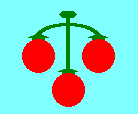 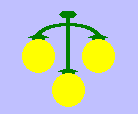 |
3 types of boundaries to Lithospheric plates:
- Divergent (constructive)- plates move apart and new material (lava/land) is formed.
- Convergent (destructive) – one plate is pushed under another (because one is heavier than the other) many earthquakes/volcanoes found here.
- Transform fault/boundary – two plates grind/slide past another. Many earthquakes occur here. (San Andreas fault)
3 types of earthquake waves: P (Primary) waves, S (Secondary) waves and L/R (Love & Rayleigh) waves:
P (stands for prima, Latin for first)- Its motion is the same as that of a sound wave in that, as it spreads out, it alternately pushes (compresses) and pulls (dilates) the rock. These P waves are able to travel through both solid rock, such as granite mountains, and liquid material, such as volcanic magma or the water of the oceans:
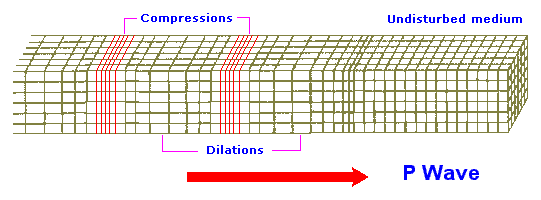
S (stands for secunda, Latin for second)- The slower wave through the body of rock is called the secondary or S wave. As an S wave propagates, it shears the rock sideways at right angles to the direction of travel. If a liquid is sheared sideways or twisted, it will not spring back, hence S waves cannot propagate in the liquid parts of the earth, such as oceans and lakes:
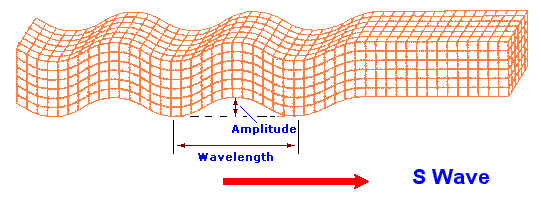
Love & Rayleigh waves- The third general type of earthquake wave is called a surface wave, reason being is that its motion is restricted to near the ground surface. Such waves correspond to ripples of water that travel across a lake. Surface waves in earthquakes can be divided into two types. The first is called a Love wave. Its motion is essentially that of S waves that have no vertical displacement; it moves the ground from side to side in a horizontal plane but at right angles to the direction of propagation. The horizontal shaking of Love waves is particularly damaging to the foundations of structures:
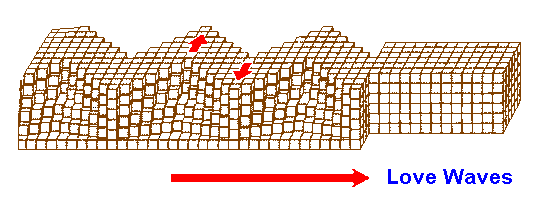
The second type of surface wave is known as a Rayleigh wave. Like rolling ocean waves, Rayleigh waves move both vertically and horizontally in a vertical plane pointed in the direction in which the waves are travelling:
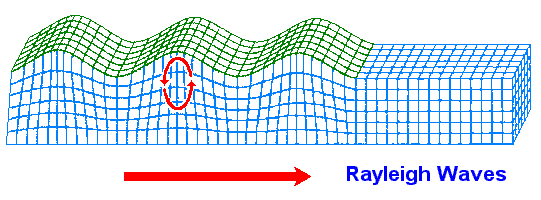
Image and information source:
http://www.allshookup.org/quakes/wavetype.htm
3 to 1 ratio with respect to the so-called four types of Lava:
- 1 of 3 = Dark colored rich in iron and magnesium. When it cools it forms basalt.
- 2 of 3 = Light colored rich in iron, magnesium and silicon. Forms Rhyolite when cooled.
- 3 of 3 = Medium colored combination of both dark and colored forms andesite when cooled.
- 1 of 1 = Contains large amounts of steam and carbon dioxide as well as having many holes in it when it cools. It forms Pumice and Scoria.
3 to 1 ratio of the so-called four types of volcanic rock fragments:
- 1 of 3 = Volcanic dust- very fine particles as small as flour
- 2 of 3 = Volcanic ash- size of a grain of rice
- 3 of 3 = Cinder- small volcanic bombs the size of meatballs. They are molten (lava) when they are ejected and harden as they travel through the air.
- 1 of 1= Volcanic bombs- large rock particles. Some can be the size of watermelons and weigh several metric tons.
(Both 1 & 2 can be carried around the world by wind)
3 types of volcanoes:
Cinder cones- made mostly of cinders and other rock particles. Have a narrow base and steep sides.
Shield volcano- has runny lava. Very quiet eruptions. Lava forms a gently sloping dome shaped mountain.
Composite volcano- built of alternating layers of rock and lava. It forms a large cone shaped mountain.
3 areas that most major earthquakes and volcanoes occur:
- The Ring of Fire – all around the edge of the Pacific.
- Near the Mediterranean Sea across Asia into India.
- Iceland to the middle of the Atlantic Ocean.
http://www.earthscienceclass.com/lectures/EarthProcesses.htm
The situation at the level of molecular physics can be summarized by saying that there are three main types of molecular arrangement:
- Crystalline Solids- molecules are ordered in a regular lattice.
- Fluids- molecules are disordered and are not rigidly bound.
- Glasses- molecules are disordered but are rigidly bound.
http://math.ucr.edu/home/baez/physics/glass.html
This article is excerpted from “Seedless Watermelon Production” by Jerry Parsons, Larry Stein, Tom Longbrake, Sam Cotner, and Jerral Johnson, published by the Texas Agricultural Extension Service.
The seedless watermelon is now a reality. Seedless watermelons -- sweet inside but without the numerous seeds found in conventional watermelons -- are the ultimate in convenience food. The obvious question asked about growing seedless watermelons is: ‘How does one obtain seed of a seedless watermelon?’ Obviously, you cannot save seed from a seedless watermelon. So, where do the seeds come from? Simply stated, the chromosome number (threadlike bodies within cells that contain the inheritance units called genes) of a normal watermelon plant is doubled by the used of the chemical colchicine. Doubling a normal (diploid) watermelon results in a tetraploid (have four sets of chromosomes) plant. When the tetraploid plant is bred back or pollinated by a diploid or normal plant, the resulting seed produces a triploid plant that is basically a ‘mule’ of the plant kingdom, and produces seedless watermelons.
Each planting of seedless watermelons actually produces three different types of watermelons: the regular seeded watermelons (from pollinator plants), the true seedless melons, and a light-green tetraploid melon that produces a very limited number of seed from which next year’s planting can be made.
By Dr. Douglas F. Welsh, Extension Horticulturist, Texas A&M University
As you place plants into the landscape, try to segregate them based on irrigation needs. This prevents you from over-watering one plant type to meet the needs of another. Every plant in the nursery or garden center truly has a place in a water-wise landscape. It’s not which plant you use, but where you put it.
Three different plant zones should be incorporated into a water-efficient landscape:
Regular Watering Zone- Plants in this zone would require watering once every week or more, once established, in the absence of rain.
Occasional Watering Zone- These plants would require watering once every two or three weeks, once established, in the absence of rain.
Natural Rainfall Zone- Plants in this Zone would require only natural rainfall, once established.
http://horticulture.tamu.edu/newsletters/hortupdate/lgnmay99.html
- 3 main best known types of melons sold in U.S. grocery stores: Watermelons, Honeydews, Cantaloupes
- 3 main ways watermelons are sold in grocery stores: Whole ~ Half ~ Quarter
- Triangular "plug" (small section) is cut by some produce managers in order to let a customer taste a chosen watermelon.
- 3 main shapes to watermelons: Oblong ~ Round ~ Oval
- 3 varieties of watermelon "flesh": Red ~ Yellow ~ Orange (the orange variety is said to have a lot of betacarotene like carrots.)
href="http://www.wholehealthmd.com/refshelf/foods_view/0,1523,57,00.html
The amount of seed you need depends on seed weight, spacing, and germination. Usually, 1 to 3 pounds of open pollinated seeds per acre are enough.
3 types of the Anthracnose Fungus which can infect watermelons: Races 1, 2, and 3.
3 X 3 inch containers are recommended for watermelon transplants.
3 to 1 ratio of the so-called four main types of street lighting used since the 1940s in the United States:
- 1 of 1 = Incandescent
- 2 of 2 = Fluorescent
- 3 of 3 = Low Pressure Sodium
- 1 of 1 = High Intensity Discharge
- (3 types of High Intensity Discharge:) Mercury Vapor ~ Metal Halide ~ High Pressure Sodium
http://www.eskimo.com/~jrterry/lamp_types.html
3 types of rooms consumers should consider with respect to glass (plant growing) enclosures: Three-season rooms ~ Year-round insulated rooms ~ Solariums.
3-legged "stool" of retirement:
- Savings.
- Retirement plan.
- Social Security
http://www.network-democracy.org/social-security/ff/faq/original.html
- 3 main theories of urban land use: Concentric-ring theory ~ Sector theory ~ Multiple-nuclei theory.
3-patterned reference by F. Scott Fitzgerald, 1896- 1940: In a real dark night of the soul it is always three o'clock in the morning, day after day.
- 3-patterned "P" reference by Charlie Chaplin: All I need to make a comedy is a park, a policeman and a pretty girl.
- 3-patterned reference by Lewis Carroll: What I tell you three times is true.
- 3rd century BC: Calculus was originated by Archimedes.
Triumvirates were a ruling board or commission of three men in ancient Rome:
The First (unofficial) Triumvirate was the alliance of Julius Caesar, Pompey, and Marcus Licinius Crassus formed in 60 B.C. The three men were able to control Rome, and the alliance aided Caesar's rise to power by giving him the opportunity to pursue the (3) Gallic Wars.
The Second (official) Triumvirate was legally established as the tresviri rei publicae constituendae (triumvirate for reestablishing the public welfare) in 43 B.C. for five years, and it was renewed in 37 B.C. The members were Octavian Augustus, Marc Antony, and Marcus Aemilius Lepidus (d. 13 B.C.). This group was granted enormous power by the senate. Lepidus was deposed in 36 B.C., and Antony was defeated at Actium in 31 B.C., leaving Octavian at the head of the Roman Empire.
http://www.encyclopedia.com/articles/13064.html
3 educational objectives, called Bloom's taxonomy, (B.S. Bloom): Cognitive ~ Affective ~ Psycho-motor
Jeremy Bentham (1748-1832), declared that the "utility" of any law is to be measured by the extent to which it promotes the pleasure, good, and happiness of the people concerned.
Ancient Greek astronomer/philosopher Anaximander claimed that the Earth was a cylinder three times wider than it is deep.
Article 2, Section 1 of the U. S. Constitution created the Electoral College. Each state receives as many electoral votes as it has Senators and Representatives. Therefore, each state, including the District of Columbia, will have at least three electors. (This act enforced the desired means of minimizing the effectiveness of the popular vote. In essence it created an overriding disparity of importance to a select few who would then choose which candidate should be considered for office. The collective Will Of The People became ever more-so relegated to negligibility...H.O.B.) |
3 times in 19th Century American Election History a candidate has won the popular vote but lost the election:
http://www.infoplease.com/ipa/A0781450.html
In 1824, Andrew Jackson won both the popular and the electoral vote—that is he received more votes than any of the other candidates. But, no one in the four-man race won a majority, or more than 50%, in the Electoral College, so the House of Representatives decided the outcome. The House picked John Quincy Adams, who had come in second in the popular and electoral votes.
In 1876, Samuel J. Tilden won 51% of the popular vote, while Rutherford B. Hayes captured 48%. However, Hayes won 185 electoral votes, while Tilden got 184. A special electoral commission picked Hayes to be president.
In 1888, Benjamin Harrison became president by winning 233 electoral votes, even though he received only 47.8% of the popular vote. His opponent, Grover Cleveland, garnered 48.6% of the popular vote, yet received only 168 electoral votes.
In other words, here are three prime examples that the votes of individual Americans are set aside (as being worthless) in order that only a handful of individuals are left to select the outcome of an election. When the Supreme Court of the 2000 Presidential election chose George W. Bush, there was even a smaller handful of people deciding the outcome of a Nation... to so much regret... and the people sat back and did nothing. They deserved all the hell which was to befall them.
http://www.infoplease.com/ipa/A0760592.html
--- John Quincy Adams ---
http://www.infoplease.com/ipa/A0760591.html
--- Samuel J. Tilden ---
http://www.infoplease.com/ipa/A0101175.html
--- Benjamin Harrison ---
http://www.infoplease.com/cgi-bin/id/A0760608.html
--- Grover Cleveland ---
http://www.infoplease.com/ipa/A0760607.html
--- Campaign 2000 The Electoral College ---
http://www.infoplease.com/spot/campaign2000race.html
Three types of drugs are used in treating and preventing asthma attacks:
- Bronchodilators relax the smooth muscles that line the airway.
- Corticosteroids block the inflammation that narrows the airways.
- Cromolyn also is taken regularly to prevent asthma attacks and may be used alone or with other asthma medicines.
3 types of Influenza viruses recognized by the American CDC (Center for Disease Control): Type A ~ Type B ~ Type C.
Three types of drugs combined to keep the HIV virus in check (known as Highly Active Antiretroviral Therapy [HAART], and is sometimes referred to as a coctail of drugs):
| Name | Acronym | Function |
| Nucleoside reverse transcript inhibitors | NRTI | Blocks reverse transcription, when viral DNA is created from RNA, by providing "decoy" building blocks |
| Non-nucleoside reverse transcript inhibitors | NNRTI | Also blocks reverse transcription by binding and restricting the activity of the reverse transcriptase enzyme |
| Protease inhibitors | PI | Blocks protease, a necessary enzyme for virus reproduction |
http://www.forbes.com/2001/06/13/0613sf.html
3 main types of inhalants abused by those attempting to get "high":
Are liquid compounds of carbon that have the power to break down, or dissolve, other carbon compounds. Organic solvents are also highly volatile; they readily evaporate from a liquid to a gas or aerosol, which can be inhaled. Examples are gasoline, lighter fluid and butane lighter fuel, spray paint, paint thinners and removers, transparent glue, rubber-cement thinner, hair spray, nail polish remover, degreasers, and cleaning fluids.
Are compounds of nitrogen and act mainly as vasodilators, causing the walls of blood vessels to relax so that the vessels enlarge, or dilate. They are used medically to relieve attacks of angina chest pain caused by insufficient blood flow in the vessels serving the heart. They also tend to depress the activity of the central nervous system, producing the giddiness and euphoria of a high. The most commonly abused are amyl nitrite and butyl nitrite.
Commonly called laughing gas, was the first inhalant used for recreational purposes.
Organic solvents -
Nitrites -
Nitrous oxide, -
H.O.B. Note: The original link for the above information was found to be unservicable (it no longer worked.) I replace the link with one provided by the person (Hope Haskins, Research Assistant) who notified me... Not because there necesarily is an obvious "three" at the site, but because the site's information is relevant:
http://www.recoveryconnection.org/
3 types of drugs most often used in the past to treat depression: Tricyclic antidepressants ~ Monoamine Oxidase Inhibitors (MAOIs) ~ lithium>
3 types of bicycles from different perspectives:
- Lightweight (ten-speed) ~ ATV (mountain bike) ~ BMX (one-speed)
- Road ~ Touring ~ Racing
- 1 front sprocket ~ 2 font sprockets ~ 3 front sprockets (sprockets are technically referred to as chainrings)
- Unicycles~ Bicycles~ Tricycles
 Unicycle |
Bicycle |
Tricycle |
3 types of stationary bikes: Upright~ Dual-action upright~ Recumbent
Short Wheel Base (SWB)- This has the seat immediately in front of the back wheel with the bottom bracket placed forward of the front wheel. Wheel size is from 24" to 27" (700mm) on the back and 16" to 24" on the front; wheelbase is generally 35 to 45 inches. The SWB is the sports car of recumbents.
Compact Long Wheel base (CLWB)- The seat is either just in front of the back wheel or over it; as well, the bottom bracket is behind the front wheel. Wheel size is generally 16" to 24" front and back; wheel base is about 45" to 65". These are usually the most inexpensive and popular recumbents.
Long Wheel Base (LWB)- These have both the bottom bracket and the seat between the wheels, thereby giving the bike a long (more than 65") wheel base and a low centre of gravity. The front wheel is 16" to 24" while the back wheel is generally 24" to 27" (700 mm) These are the most comfortable recumbents.
http://www.vcn.bc.ca/cccts/recumbents.html
3 different types of inner-tube valves for bicycles:
- Dunlop or BLITZVENTIL - the usual (or typical) valve
- Schrader or car valve - adapted from the automobile industry. Found mainly on mountain bikes.
- Sclaverand or racing valve, now in use for nearly all types of bicycles. The valve is suited for the highest pressure.
http://www.sks-germany.de/new/sks-seiten/checkup/luftdruck_e.htm
3 types of inner-tube valves used on bicycles from another perspective: Presta ~ Schrader ~ Woods
http://www.sheldonbrown.com/gloss_u-v.html
3 types of rowing bicycles, each one having distinctive specifications:
- Type 1- the high-frame type.
- Type 2- the latest model, with a medium height frame.
- Type 3- the low-frame high-velocity bike
http://gallery.uunet.be/Paul.deweert/price.htm
3 types of recreational vehicles: Snowmobiles ~ Bicycles ~ ATV's (all terrain vehicles sometimes called 2- wheelers/dirt bikes, 3- wheelers/off road trikes, 4- wheelers)
- 3 types of bicycle brakes: Caliper ~ Coaster ~ Disk
- 3 types of common police patrol: Foot~ Mobile~ Fixed
- 3 types of Olympic games bicycle races: Road~ Track~ Mountain Bike
- 3 types of cycling tourism in Britain: Cycle touring holidays~ Cycling on holidays~ Mountain biking
3 types of bikeways adopted by the city of Santa Monica,
California:
(A bikeway is defined as any road, path, or way which
is specifically designed for bicycle travel, whether such facilities are for the
exclusive use of bicycles or are shared with other forms of
transportation.)
- Bike Paths that completely separate bicycles from motor vehicles.
- Bike Lanes are signed and striped lanes along the roadway.
- Bike Routes are signed routes which bicyclists share with motor vehicles.
3 distinct types of batteries presently in use on electrically assisted bicycles:
- Sealed "lead acid"
- "Nickel-cadmium"
- "Nickel-metal-hydride"
- 3 types of eco-transport in Albena: Mini-trains ~ Rickshaws ~ Bicycles
- 3 types of eating for cyclists: Pre-workout ~ During workout ~ Post (recovery) workout
- 3 general types of sparkplug heat ranges: Hot ~ Standard ~ Cold
3 basic types of smoke that emit from internal combustion engines:
- Black- Carbon
- White- Water vapor
- Blue- Oil
- 3 basic types of sparkplug fouling: Carbon fouling ~ High speed (lead) fouling ~ Oil/ carbon fouling
- 3 manufacturing plants produced 1955 Plymouths: Detroit ~ Evansville ~ Los Angeles
- 3 basic types of carburetors: 1 barrel ~ 2 barrel ~ 4 barrel
- 3 main types of fuel atomization systems: Carburetors ~ Throttle-body fuel injection ~ Fuel Injection.
- 3 popular carburetor types: Butterfly valve~ Round slide~ Flat-slide
- 3 types of oil pumps available for many engines: Standard ~ High pressure ~ High volume
- 3 types of gas pumps: External mechanical ~ In gas tank electrical ~ External electrical
- 3 types of piston production methods: Cast ~ Hypereutectic ~ Forged
- 3 types of air/fuel mixtures: Rich ~ Optimal ~ Lean
- 3 types of accessory "power"-producing products for engines: Nitrous oxide ~ Turbo-charging ~ Super-charging
3 types of atmospheric phenomena affecting the air/fuel mixture:
- Ambient air temperature
- Humidity
- Barometric pressure/altitude
3 steps to selecting a high performance sparkplug: One-shell design ~ Electrode & Gap ~ Heat range
3rd row of seats in minivans and SUV's (standard utility vehicle) is becoming an option of increased desirability (2003).
3 phase ignition timing lag:
According to research by Jacobs Electronics, there is a lapse between the time your timing light flashes and the actual beginning of the burning of the mixture in the combustion chamber (as a whole called ignition lag).
1st phase- is called the voltage rise time lag, which is the time lapse from when the spark voltage first starts and your ignition timing light flashes till the spark current begins.
2nd phase- is called the transport lag and is the time lapse between when the current begins and a ball of flame is initiated. This ball of flame starts at the diameter of the sparkplug gap.
3rd phase- is the time lapse between the beginning of the ball of flame until it has grown to 0.100 inch (2.54 mm) diameter, this part of the ignition lag is called the growth lag, after this the flame propagates very rapidly.
http://www.castensdynojet.com/sparkplugs.htm
- 3 basic diagnostic criteria for sparkplugs: Good ~ Fouled ~ Over-heated
- 3 types of noisest hammers: Diesel ~ Pneumatic ~ Steam (compared to 1 quieter: Hydraulic)
- 3 basic types of forging machines: Rolls ~ Drop hammers ~ Presses
- 3 types of firearms a cowboy action shooter must be proficient with: Revolvers ~ Rifles/carbines ~ Shotguns
- 3 primary steps of paper production: Pulping & delignifying the wood ~ Bleaching the pulp ~ Producing paper from the pulp
- 3 natural healers: Nature~ Time~ Patience
- 3 basic types of carbohydrates: Simple (sugars) ~ Complex (starches) ~ Fiber
- 3 main types of fungal lawn diseases: Parasites ~ Water molds ~ "Imperfect" fungi
- 3 known sources of stem cells: Bone marrow ~ Peripheral blood ~ Umbilical cord blood
- 3 to 1 ratio of position categories in relay races: 1st leg ~ 2nd leg ~ 3rd leg... Anchor
- 3 hours a shift on one's feet should be the maximum for a pregnant woman.
- 3 items most clinicians ask pregnant women keep to one cup or less of per day: Coffee~ Tea~ Cola
3 types of drugs considered to be harmful to the fetus as well as the nursing baby:
Pharmaceutical drugs — prescription and over-the-counter medicines
Commonly used drugs — tobacco, alcohol, caffeine
Illegal drugs — such as marijuana, heroin, crack, speed, PCP, ketamine ("Special K"), Ecstasy, etc...
http://www3.plannedparenthood.org/PARENTS/Prenatal-page3.html
3 types of vegetarians:
Lacto-ovo-vegetarians: Don't eat any animal flesh (red meat, white meat, or fish). They do eat dairy products and eggs.
Lacto vegetarians: Don't eat any animal flesh or eggs. They do eat dairy products.
Vegans: Don't eat any animal flesh, eggs, or dairy products. They only eat plant foods.
http://www.hirepgym.com/case_for_a_vegetarian_diet____th.htm
3 types of drugs that are typically misused:
- Opioids
- Central Nervous System (CNS) Depressants
- Stimulants
Herb O. Buckland
herbobuckland@hotmail.com